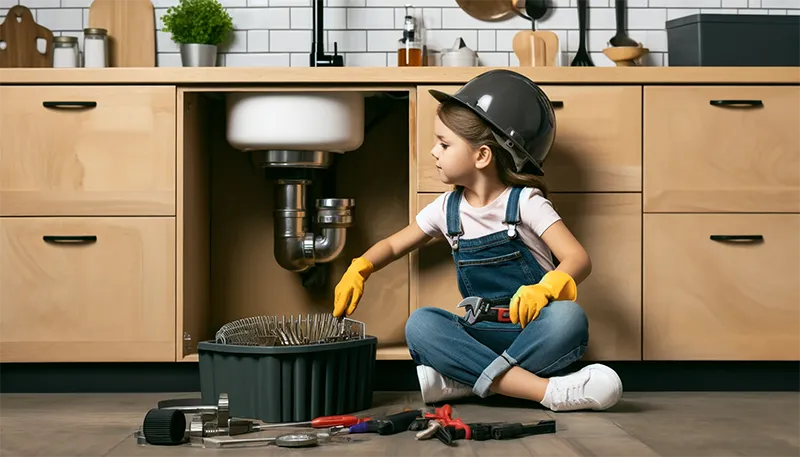A garbage disposal is a handy kitchen appliance, but when it stops working properly, it can disrupt your daily routine. From clogs and jams to leaks and foul odors, knowing how to identify and fix common garbage disposal failures can save you time, money, and frustration.
In this guide, we’ll cover the most frequent issues with garbage disposals and provide step-by-step solutions to get your unit back in working order.
The Garbage Disposal Won’t Turn On
Possible Causes:
- Power Supply Issues: The unit may not be getting power.
- Tripped Reset Button: The internal circuit breaker may have tripped.
- Faulty Wiring: Loose or damaged electrical connections.
Solutions:
- Check the Power Connection:
- Ensure the disposal is plugged in.
- Check the circuit breaker in your electrical panel and reset if necessary.
- Press the Reset Button:
- Locate the red reset button on the bottom of the disposal unit.
- Press it firmly; if it pops out, it indicates the unit has reset.
- Inspect the Wiring:
- Turn off the power at the circuit breaker.
- Check the wiring connections under the disposal and tighten any loose wires.
The Disposal Is Jammed or Clogged
Signs:
- Humming sound when turned on but no grinding.
- Unit won’t spin or shuts off quickly.
Causes:
- Hard objects like bones, utensils, or fruit pits stuck in the grinding chamber.
- Fibrous foods like celery or onion skins causing blockage.
Solutions:
- Turn Off Power:
- Unplug the unit or turn off power at the circuit breaker.
- Use a Hex Wrench:
- Insert a hex (Allen) wrench into the hole at the bottom of the unit.
- Turn it back and forth to manually rotate the flywheel and dislodge the jam.
- Remove Debris:
- Use pliers to carefully remove any objects stuck inside the disposal.
- Never use your hands to reach inside the unit.
- Reset and Test:
- Press the reset button and turn the power back on.
- Run cold water and test the disposal.
The Disposal Is Leaking
Possible Leak Points:
- Sink Flange: The seal between the sink and the disposal.
- Dishwasher Hose Connection: Where the dishwasher hose connects to the disposal.
- Discharge Pipe: The pipe connecting the disposal to the drain.
Solutions:
- Tighten Connections:
- Use a wrench to tighten any loose connections at the dishwasher hose or discharge pipe.
- Reapply Plumber’s Putty:
- If the leak is at the sink flange, remove the disposal, clean off old putty, and apply fresh plumber’s putty before reseating the flange.
- Replace Gaskets:
- Inspect gaskets and seals for damage and replace if worn out.
The Disposal Is Making Loud or Unusual Noises
Causes:
- Foreign objects like metal or glass inside the unit.
- Loose components or mounting hardware.
- Damaged grinding plates or impellers.
Solutions:
- Turn Off Power:
- Unplug the disposal or turn off the circuit breaker.
- Check for Foreign Objects:
- Shine a flashlight into the disposal and use pliers to remove any objects.
- Tighten Loose Parts:
- Check the mounting ring and screws to ensure they’re secure.
- Inspect for Damage:
- If grinding components are damaged, consider replacing the unit.
The Disposal Drains Slowly
Causes:
- Clogged P-trap or drain pipe.
- Food waste buildup in the grinding chamber.
Solutions:
- Clean the P-Trap:
- Place a bucket under the P-trap (curved pipe under the sink).
- Unscrew the slip nuts and remove the trap.
- Clear any debris and reinstall.
- Use Baking Soda and Vinegar:
- Pour 1/2 cup baking soda and 1 cup vinegar into the disposal.
- Let it sit for 10-15 minutes, then flush with hot water.
Persistent Odors from the Garbage Disposal
Causes:
- Food particles and grease buildup.
- Mold or bacteria growth under the splash guard.
Solutions:
- Baking Soda and Vinegar:
- Pour 1/2 cup baking soda and 1 cup vinegar into the disposal. Let it fizz, then rinse with cold water.
- Grind Citrus Peels:
- Grind lemon or orange peels to freshen the disposal.
- Clean the Splash Guard:
- Remove and scrub the rubber splash guard with dish soap and a brush.
Preventive Maintenance Tips
Run Cold Water During Use
- Helps flush waste through the system and prevents clogs.
Avoid Grinding Certain Items
- Fibrous Foods: Celery, corn husks
- Grease and Oils: Can solidify and cause clogs
- Hard Objects: Bones, pits, metal utensils
Clean Regularly
- Weekly cleaning with baking soda and vinegar keeps the disposal fresh.
Use Ice Cubes
- Grinding ice helps clean the blades and dislodge debris.
FAQs
-
Why does my garbage disposal hum but not grind?
This indicates a jam or clogged flywheel. Use a hex wrench to manually turn the flywheel.
-
How do I reset my garbage disposal?
Press the red reset button on the bottom of the unit until it clicks.
-
Can I use chemical drain cleaners in my disposal?
No, chemical cleaners can damage the disposal. Use natural solutions like baking soda and vinegar instead.
-
How long should a garbage disposal last?
With proper maintenance, a garbage disposal typically lasts 8-15 years.
-
What should I do if my disposal leaks?
Identify the leak source and tighten connections or replace gaskets and seals.
Conclusion
Garbage disposal failures are common, but with these troubleshooting tips, most issues can be fixed easily at home.
Regular maintenance, such as cleaning and avoiding harmful items, can extend the life of your disposal and prevent costly repairs.
Have you experienced any of these garbage disposal failures? Share your solutions and tips on social media to help others keep their kitchens running smoothly!



